Pompeii’s grand theaters were the epicenter of the city’s vibrant social and cultural life. These impressive architectural marvels offered entertainment to thousands of spectators, providing a glimpse into the community’s daily activities. In stark contrast, the Garden of Fugitives presents a haunting tableau frozen in time – preserved casts of victims, a poignant reminder of the catastrophic impact of the volcanic eruption that devastated the city. While the theaters speak to Pompeii’s former glory, the Garden of Fugitives reveals the tragic human cost of the disaster, leaving visitors to ponder the delicate balance between life and the forces of nature.
Key Points
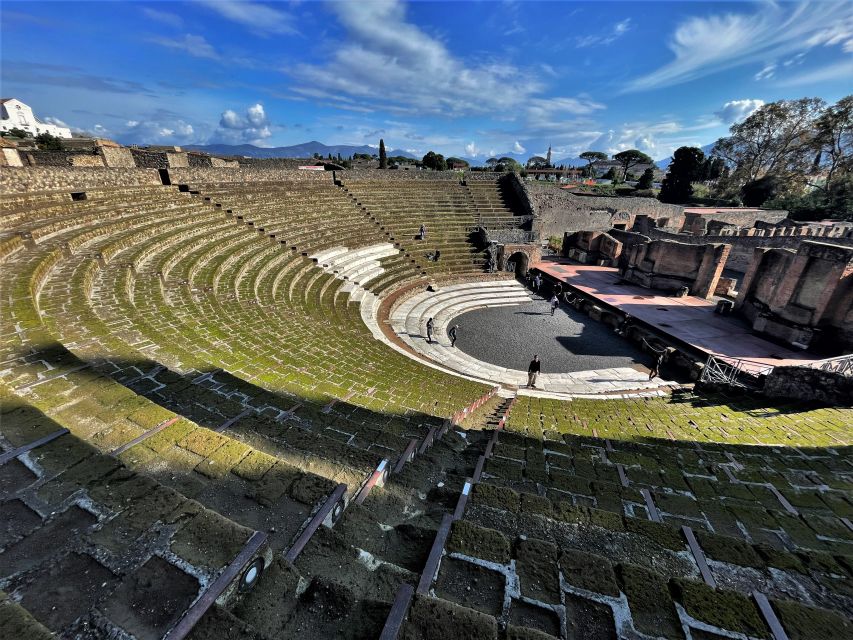
- Pompeii’s theaters were grand hubs of entertainment, with the Grand Theater seating up to 5,000 people and offering stunning views of Mount Vesuvius.
- The Garden of Fugitives provides a haunting glimpse into the human tragedy of the Mount Vesuvius eruption, with preserved remains of victims frozen in their final moments.
- Pompeii’s theaters served as vital social centers for the community, allowing citizens to come together for performances and entertainment.
- The preserved casts of bodies in the Garden of Fugitives offer a sobering and emotional reminder of the devastating impact of the volcanic disaster.
- Pompeii’s theaters and the Garden of Fugitives provide unparalleled insights into the daily life and culture of ancient Roman civilization, transporting visitors back in time.
Exploring Pompeii’s Archaeological Significance
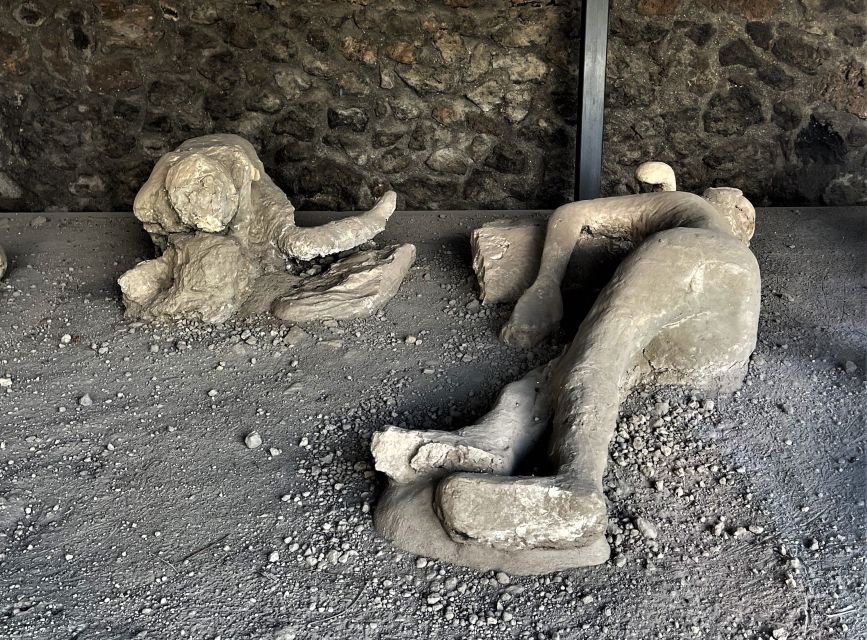
Pompeii is widely regarded as one of Europe’s most significant archaeological sites, offering unparalleled insights into the daily lives and culture of the ancient Roman civilization.
The remarkably well-preserved ruins of this once-thriving city, destroyed by the eruption of Mount Vesuvius in 79 AD, provide a unique window into the past.
Visitors can explore the intricate network of streets, homes, businesses, and public spaces that were integral to the daily functioning of the city.
The excavations have unearthed a wealth of artifacts, from household items to monumental structures, shedding light on the sophistication and complexity of Roman urban planning and architecture.
Pompeii’s archaeological significance lies in its ability to transport visitors back in time and immerse them in the vibrant world of ancient Rome.
You can also read our reviews of more tours and experiences in Pompei.
Taking in Pompeii’s Daily Life
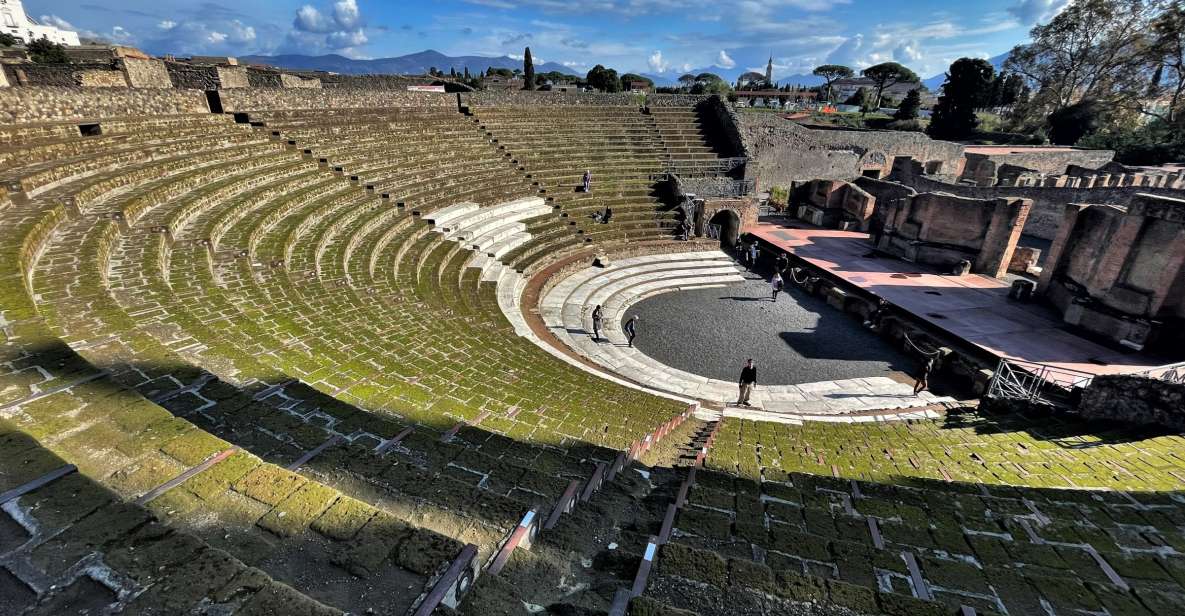
Visitors can often enjoy the daily life of ancient Pompeii by exploring the city’s well-preserved theaters and the haunting Garden of Fugitives. The theaters provided entertainment for citizens, while the Garden of Fugitives offers a poignant glimpse into the last moments of those who died during the Mt. Vesuvius eruption in 79 AD.
| Theaters | Garden of Fugitives |
|---|---|
| Where citizens gathered for entertainment | Contains casts of victims frozen in their final moments |
| Impressive architecture with seating for thousands | Offers a somber, powerful reminder of the eruption’s devastation |
| Provided a social hub for the community | Allows visitors to connect with the personal tragedies of the past |
This immersive experience helps bring the bustling spirit of ancient Pompeii to life.
Witnessing the Vesuvius Eruption’s Aftermath
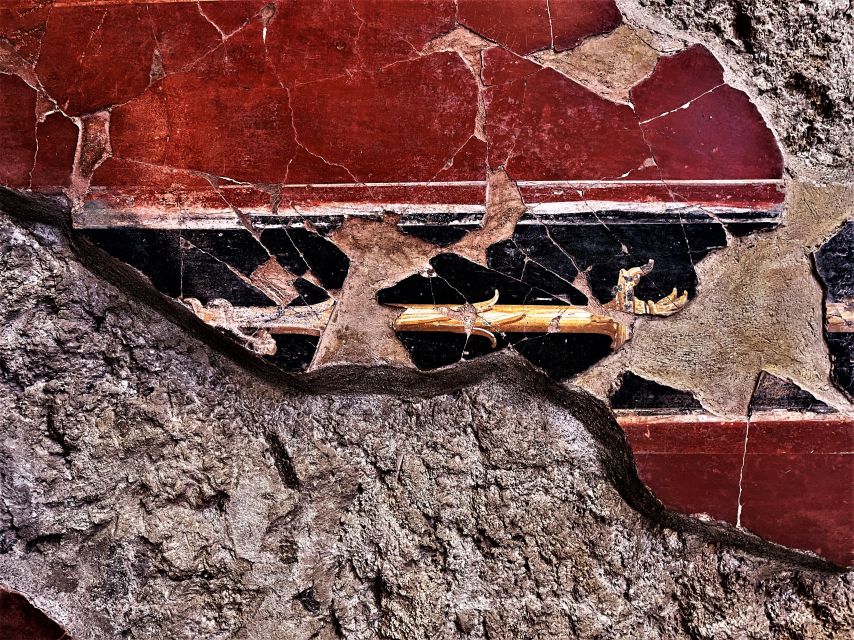
The Garden of Fugitives offers visitors a haunting glimpse into the eruption’s aftermath, with its casts of victims frozen in their final moments of life.
Here, one can observe the agonizing positions of those who were caught unaware by the volcanic disaster – a woman cradling a child, a man shielding his face, and others huddled together in a futile attempt to escape.
These plaster casts, made by pouring material into the voids left by the decomposed bodies, provide a powerful and poignant reminder of the human tragedy that unfolded in Pompeii on that fateful day.
Through this experience, visitors can gain a deeper understanding of the catastrophic impact of the Mount Vesuvius eruption.
Theaters of Pompeii: a Glimpse Into the Past
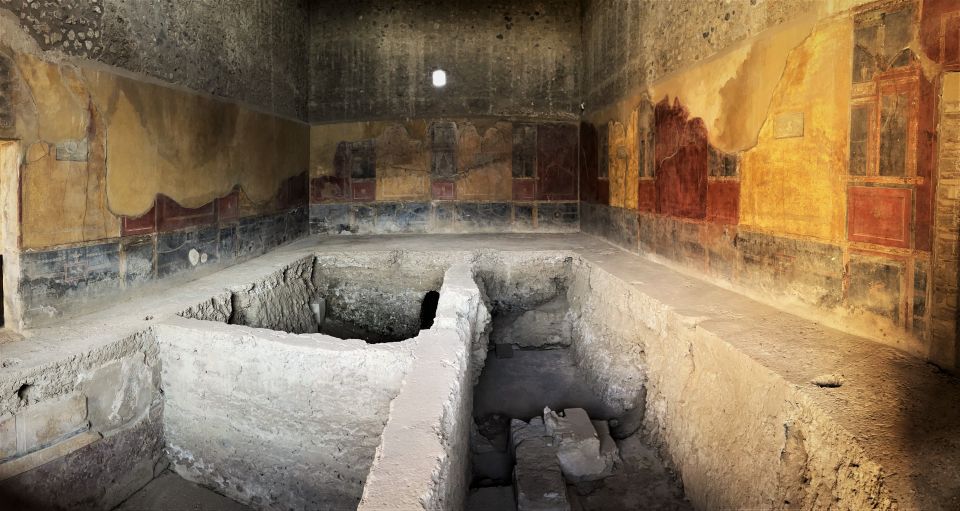
The grand theaters of Pompeii offer a captivating glimpse into the vibrant cultural life that once thrived in this ancient Roman city. These impressive structures were central hubs for entertainment, hosting a variety of performances, from plays and concerts to gladiatorial events.
The Grand Theater, with its impressive seating capacity of 5,000 and stunning views of Mount Vesuvius, was one of the key features of the Pompeii theaters.
The Small Theater was a more intimate venue for poetry readings, music, and dramatic productions.
The Covered Theater was a unique enclosed space for performances during inclement weather.
The Teatro Piccolo was a smaller stage used for rehearsals and private events.
These well-preserved theaters provide a remarkable window into the past, allowing visitors to imagine the bustling cultural scene that once filled the streets of Pompeii.
More Great Tours NearbyThe Garden of Fugitives: Preserved Victims
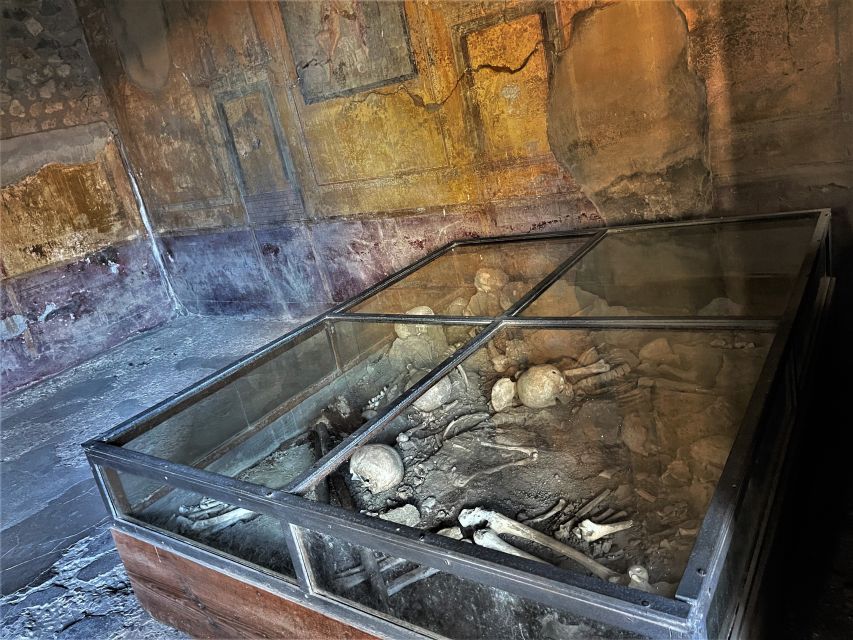
One of the most poignant and haunting sites in Pompeii is the Garden of Fugitives, where visitors can witness the preserved remains of those who perished during the Mount Vesuvius eruption in 79 AD.
The casts of these victims, captured in their final moments, offer a sobering glimpse into the human tragedy that unfolded on that fateful day. Visitors can observe the bodies of men, women, and children, forever frozen in time, providing a powerful and emotional connection to the past.
The Garden of Fugitives serves as a somber reminder of the destruction wrought by the volcano and the resilience of the human spirit in the face of such catastrophic events.
Essential Buildings and Structures in Pompeii
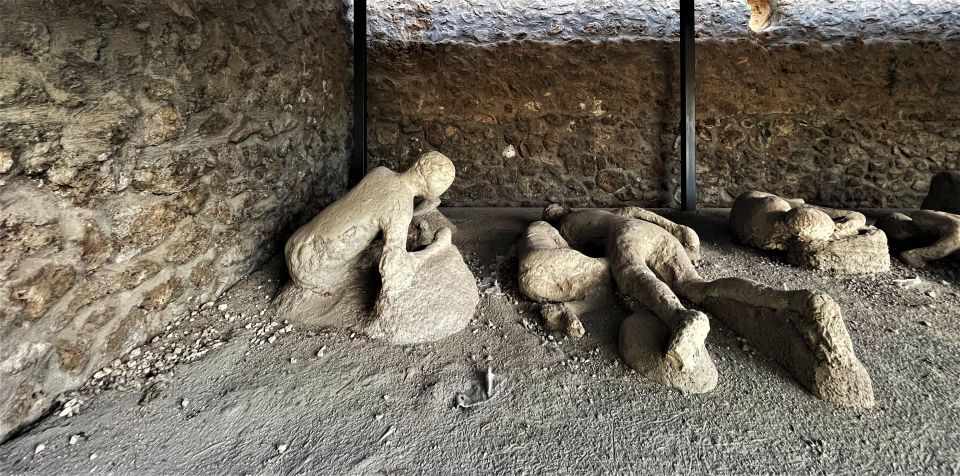
Pompeii was home to numerous essential buildings and structures that were central to daily life, including various temples, theaters, baths, and residential dwellings. These architectural wonders, many of which have been meticulously preserved, offer visitors a glimpse into the vibrant and bustling city that was destroyed by the catastrophic eruption of Mount Vesuvius in 79 AD.
Some of the most notable structures include:
- The Lupanar, a two-story building that served as a brothel
- The Thermopolium, a fast-food restaurant and bar
- The Amphitheater, the oldest surviving Roman amphitheater
- The Macellum, a large market hall that sold a variety of goods
These well-preserved buildings provide invaluable insights into the lives and routines of Pompeii’s inhabitants.
Guided Tour: Highlighting Key Attractions

On this guided tour, visitors can explore Pompeii’s renowned Theaters and the captivating Garden of Fugitives, offering a poignant glimpse into the city’s final moments.
At the Theaters, guests will learn about the critical role these structures played in the daily life of Pompeii’s residents.
In the Garden of Fugitives, visitors can observe the haunting casts of the victims who perished during the Mount Vesuvius eruption in 79 AD.
The expert guide will share vivid details and insights, bringing the past to life and immersing guests in the captivating history of this archaeological treasure.
Through this guided experience, visitors can gain a deeper understanding of the last days of Pompeii and the impact of the catastrophic event.
Booking and Accessibility Considerations
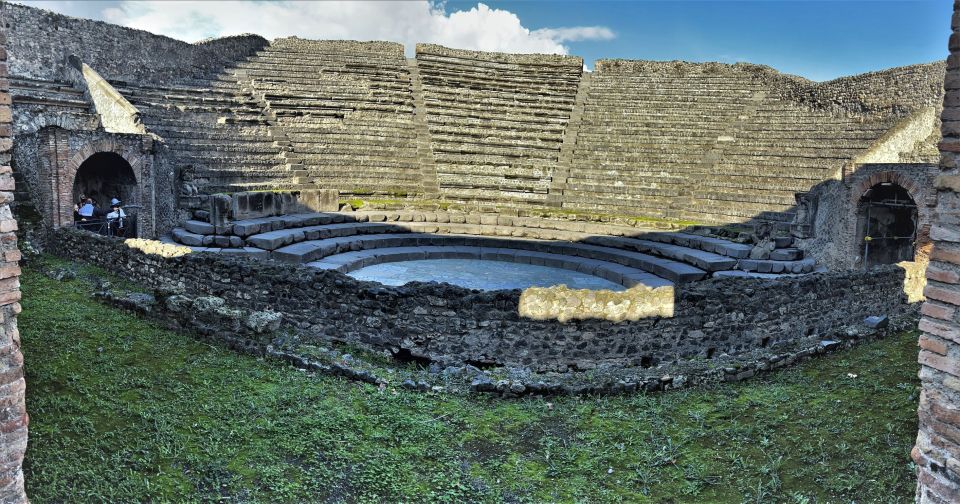
Travelers can reserve their spots and pay later to secure their place on the Pompeii tour, with free cancellation available up to 24 hours in advance. However, the tour may not be suitable for everyone.
Mobility impairments: The ancient ruins can be challenging for those with limited mobility.
Health concerns: Visitors with heart problems, respiratory issues, or recent surgeries should consult a medical professional before booking.
Pre-existing conditions: Individuals with certain medical conditions may face increased risks and should exercise caution.
Accessibility: While the tour offers skip-the-line access, the site itself may pose accessibility challenges for some visitors.
It’s essential for travelers to carefully review the tour’s limitations and plan accordingly to ensure a safe and enjoyable experience.
Frequently Asked Questions
Can I Bring My Own Food and Drinks to the Tour?
Guests can bring their own food and drinks to the Pompeii tour. However, the tour operator recommends enjoying the local cuisine and purchasing refreshments during the tour to fully take in the Pompeii experience.
Are There Any Discounts Available for Students or Seniors?
Yes, there are discounts available for students and seniors on this Pompeii tour. They can save up to 10-15% off the regular tour price with valid student or senior ID. Advance booking is recommended to secure the discounted rate.
Is There a Dress Code for the Tour?
There’s no strict dress code, but visitors should wear comfortable, weather-appropriate clothing and sturdy walking shoes. Avoid revealing or overly casual attire as the tour takes place in a historic site.
Can I Take Photographs During the Tour?
Visitors are typically allowed to take photographs during the Pompeii tour. However, it’s best to check with the tour operator beforehand, as some sites may have restrictions on photography to preserve the artifacts and experience for all guests.
Is There a Restroom Available at the Pompeii Site?
Yes, there are restrooms available at the Pompeii archaeological site. Visitors can use the facilities located throughout the site during the tour. The restrooms provide a convenient option for guests to use during the 2-hour guided experience.
Recap
Pompeii’s theaters and the Garden of Fugitives offer a captivating contrast – the former showcasing the city’s vibrant cultural life, the latter a haunting reminder of the Vesuvius eruption’s tragic impact.
Together, they provide an immersive window into Pompeii’s past, inviting visitors to explore the archaeological significance and daily life of this remarkable ancient city.
You can check availability for your dates here:More Tour Reviews in Pompei
Not for you? Here's more nearby things to do in Pompei we have reviewed
- 25 Best Tours In Pompei
- 25 Best Guided Tours In Pompei
- 3 Best Shore Excursions In Pompei
- 2 Best National Park Tours In Pompei
- 20 Best Wine Tours In Pompei
- 8 Best Cooking Classes In Pompei
- 20 Best Lunch Experiences In Pompei
- 15 Best Walking Tours In Pompei
- 2 Best Dining Experiences In Pompei
- 20 Best Private Drivers In Pompei
- 9 Best Workshops And Classes In Pompei
- 11 Best 2 Hour Tours and Experiences in Pompei
